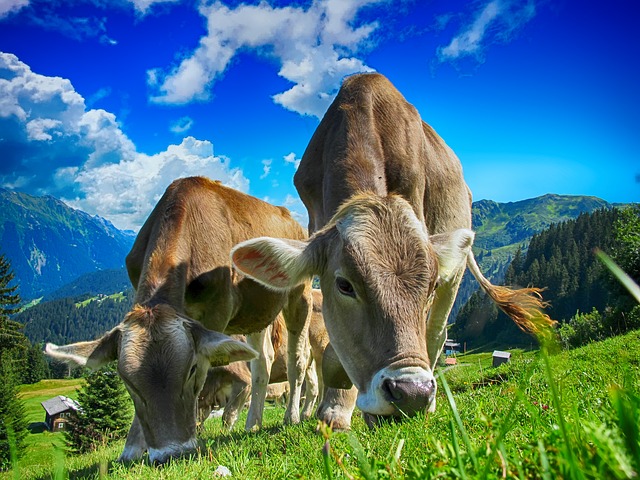
Why Beef Is NOT Destroying the Planet
As a holistic nutritionist, I’m all about the FACTS – facts that help you achieve your best health possible. And sometimes, you have to dig through a whole lot of marketing hype to get to the truth.
So today I want to tell you the truth about how red meat can actually be pretty green.
Not in color, of course, that would just be gross….but green as in GOOD for the environment!
This realization comes when you distinguish between healthy grass-fed red meat and the highly processed “red meat” (if you can call it that) often seen sandwiched between two starchy buns.
I completely agree that that type of red meat is terrible for you, and you should never eat it. But today I want to focus on the kind of red meat that is good for everyone – for you, for the environment, and for the animals.
Let’s dig in.
One of the arguments against red meat’s environmental impact is based upon the amount of water it takes to produce.
Here are the facts:
Research suggests that conventionally raised beef requires 410 gallons of water to produce just one pound of meat.
Grass-fed beef, on the other hand, requires only about 100 gallons of water to produce per pound.
When you consider the fact that certain plant-based foods like rice, walnuts, sugar and avocados require roughly 400 gallons per pound produced, grass-fed beef is the clear winner.
Ok, so beef production isn’t as water-hungry as many would like you to believe. But what about methane production? According to many, greenhouse gas emissions are another reason to avoid eating red meat.
But how much methane do grass-fed cattle really contribute to the environment?
Compared to factory-farmed cattle, their negative environmental impact is much less profound.
Some experts would like you to believe that cattle production negatively impacts our planet. What they don’t tell you is that 200 years ago, there was about 30-60 million bison roaming North America alone.
How much methane did those bison produce? About the same amount as grass-fed cattle do today.
Did it impact the environment in the same way red meat processing does today?
Of course not!
Because grass-fed animals don’t impact the environment the way that factory-farmed animals do. Randomly scattered feces across thousands of acres is far less impactful than concentrated animal feces originating from cramped factory farms.
In fact, cattle that are responsibly rotated through pasture actually HELP the environment. Here’s how:
- Their excrement adds microorganisms to the soil, increasing the biodiversity that keeps it rich and thriving.
- Their grazing stimulates grass growth.
- The very act of their roaming makes the soil more porous, allowing rainwater to collect and absorb and seeds to germinate.
One study in particular by the USDA National Resource Conservation Service portrayed this improvement in water infiltration beautifully.
When looking at cropland, conventional grazing, and rotational grazing, they revealed that it took water:
- 31 minutes to infiltrate the field of crops.
- 7 minutes to permeate the field that used conventional grazing.
- And get this – just 10 SECONDS to seep through the field using rotational grazing practices!
Researchers have long known that healthy soil is a delicate balance between proper water infiltration, bacteria, fungi, worms and other microorganisms.
Farmers have tried to mimic these things with additives like fertilizers and pesticides for years, which deplete soils and contribute to greater emissions.
But rotationally grazing cattle achieves all of this naturally.
Does that sound like something that’s terrible for you and the environment? I don’t think so.
Think for a moment about the thousands of years that humans have been eating red meat. Before the advent of modern food processing, they didn’t have all the health issues we have today.
So what does that tell you?
That it’s not the meat that’s changed, but the processing.
Popular media misrepresents beef as a high-fat, cholesterol-laden, heart-attack-driving food source.
But the facts prove otherwise.
Beef isn’t inherently bad for you – it’s the way we raise, process, and prepares it that makes it unhealthy.
Today, the majority of cattle are raised in factory farms, fed large amounts of antibiotics and processed with various chemicals and nitrates.
Grass-fed beef, however, is raised naturally, not fed antibiotics or hormones, and retains all of its health-promoting nutrients like:
- More antioxidants
- Less fat than conventional beef
- Conjugated linoleic acid (implicated in cancer prevention)
- Omega-3 fatty acids
- A substantial amount of iron
- And the list goes on
And remember, those benefits to our health care in addition to its benefits for the environment…only, of course, when it comes from 100% grass-fed cattle that practice rotational grazing.
That’s why it is so important to know where your beef comes from if you’re at all concerned about your health and our planet.
At Paleovalley, we actually visit the farms our beef comes from to ensure they are never fed a single grain AND that our farmers rotate their grazing areas in a way that actually improves the environment.
Because of the meat’s quality and mindfulness in raising, our 100% grass-fed beef sticks are a healthy, guilt-free snack that’s perfect for on-the-go living.
They’re even preserved using fermentation instead of those junk preservatives you find in virtually every other beef snack. That means each stick is naturally infused with 1 billion probiotic CFUs!
They’re also:
- Sugar-free
- Gluten free
- Artificial nitrate/nitrite free
- GMO-free
- And no antibiotics or hormones ever.
Right now they come in 4 delicious flavors:
- Original
- Jalapeno
- Summer sausage
- Garlic summer sausage
If you want to eat healthily and responsibly, click the link here see how you can grab some grass-fed beef sticks at up to 30% off!






